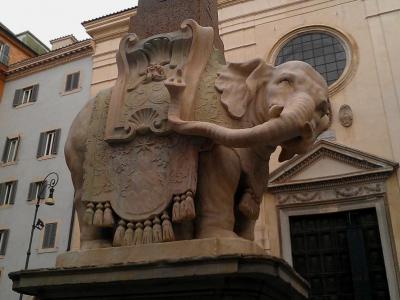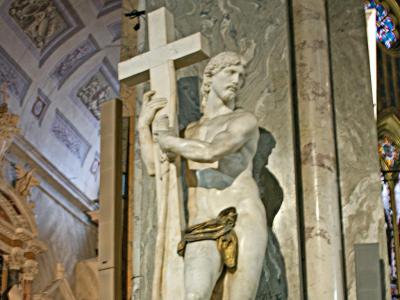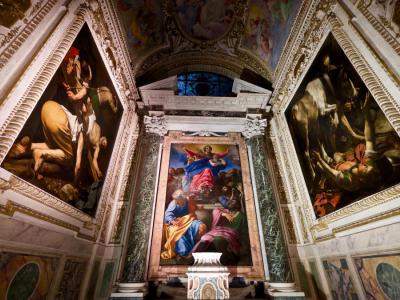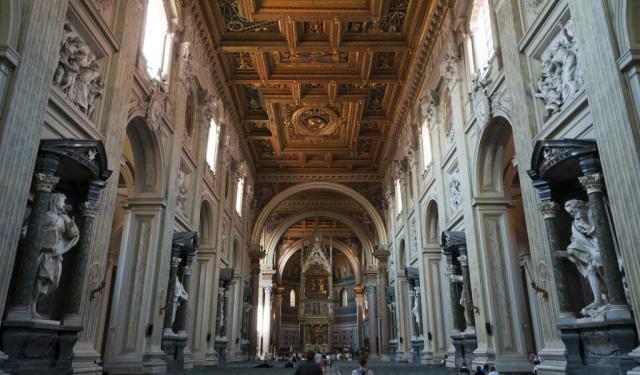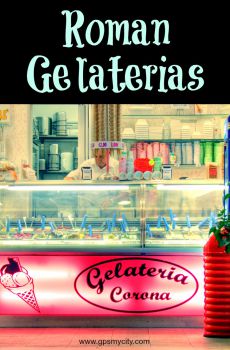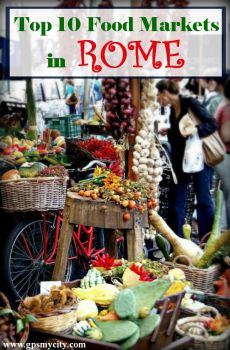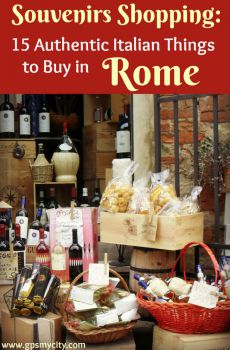Hidden Art Treasures in Rome (Self Guided), Rome
Rome is one of the world's top living museums, replete with some of the most iconic pieces of art on the face of the planet. Famous artists, such as Michelangelo, Caravaggio, Raphael, Bernini, to mention but a few, had lived and worked here and left indelible marks in the city.
Needless to say that the abundance of masterpieces makes Rome crowded with tourists anxious to see them, causing the local museums to charge hefty fees. Still, there's also a surprising number of hidden art gems in Rome that are free to look at and routinely passed by tourists totally undetected.
Indeed, Rome has numerous layers and the density of its art scene is truly mind-boggling even for a discerning traveler or culture vulture. Luckily, with a bit of insider knowledge, one can find and enjoy the works of art by renowned masters completely free of charge. Here are some of the “secret spots” worth checking out:
Saint Mary of Peace Church – rededicated to the Virgin Mary after a miraculous bleeding of a Madonna image in 1480; among other features here is the “Sibyls Receiving Angelic Instruction” fresco by Raphael.
Basilica of St. Augustine – known for plentiful artwork by Caravaggio, Raphael, Guercino and Bernini, as well as the Buongiovanni Chapel (in the left transept) decorated by Giovanni Lanfranco and the "St Thomas of Villanova Distributing Alms" sculpture by Bernini's assistant Ercole Ferrata;
Church of St. Louis of the French – a small basilica just one block from Piazza Navona; a hidden gem absolutely worth a stop, if only for the spectacular Contarelli Chapel housing the in-situ triptych by Caravaggio depicting life of St. Matthew;
Elephant and Obelisk Statue – the red granite obelisk from Egypt, dated circa 580 BC, set upon the marble elephant carved by Ercole Ferrata;
Santa Maria sopra Minerva Church – renowned, in part, for housing the Cristo della Minerva, aka “Christ the Redeemer” or “Christ Carrying the Cross” marble sculpture by Michelangelo Buonarroti.
If you’re an art lover, traveling on a budget, and willing to be whisked off the beaten path for some unusual findings in Rome, take this self-guided walk and ferret out its less touristy and overlooked, but nonetheless just as magnificent, landmarks that are still under the radar.
Needless to say that the abundance of masterpieces makes Rome crowded with tourists anxious to see them, causing the local museums to charge hefty fees. Still, there's also a surprising number of hidden art gems in Rome that are free to look at and routinely passed by tourists totally undetected.
Indeed, Rome has numerous layers and the density of its art scene is truly mind-boggling even for a discerning traveler or culture vulture. Luckily, with a bit of insider knowledge, one can find and enjoy the works of art by renowned masters completely free of charge. Here are some of the “secret spots” worth checking out:
Saint Mary of Peace Church – rededicated to the Virgin Mary after a miraculous bleeding of a Madonna image in 1480; among other features here is the “Sibyls Receiving Angelic Instruction” fresco by Raphael.
Basilica of St. Augustine – known for plentiful artwork by Caravaggio, Raphael, Guercino and Bernini, as well as the Buongiovanni Chapel (in the left transept) decorated by Giovanni Lanfranco and the "St Thomas of Villanova Distributing Alms" sculpture by Bernini's assistant Ercole Ferrata;
Church of St. Louis of the French – a small basilica just one block from Piazza Navona; a hidden gem absolutely worth a stop, if only for the spectacular Contarelli Chapel housing the in-situ triptych by Caravaggio depicting life of St. Matthew;
Elephant and Obelisk Statue – the red granite obelisk from Egypt, dated circa 580 BC, set upon the marble elephant carved by Ercole Ferrata;
Santa Maria sopra Minerva Church – renowned, in part, for housing the Cristo della Minerva, aka “Christ the Redeemer” or “Christ Carrying the Cross” marble sculpture by Michelangelo Buonarroti.
If you’re an art lover, traveling on a budget, and willing to be whisked off the beaten path for some unusual findings in Rome, take this self-guided walk and ferret out its less touristy and overlooked, but nonetheless just as magnificent, landmarks that are still under the radar.
How it works: Download the app "GPSmyCity: Walks in 1K+ Cities" from Apple App Store or Google Play Store to your mobile phone or tablet. The app turns your mobile device into a personal tour guide and its built-in GPS navigation functions guide you from one tour stop to next. The app works offline, so no data plan is needed when traveling abroad.
Hidden Art Treasures in Rome Map
Guide Name: Hidden Art Treasures in Rome
Guide Location: Italy » Rome (See other walking tours in Rome)
Guide Type: Self-guided Walking Tour (Sightseeing)
# of Attractions: 6
Tour Duration: 1 Hour(s)
Travel Distance: 2.6 Km or 1.6 Miles
Author: DanaOffice
Sight(s) Featured in This Guide:
Guide Location: Italy » Rome (See other walking tours in Rome)
Guide Type: Self-guided Walking Tour (Sightseeing)
# of Attractions: 6
Tour Duration: 1 Hour(s)
Travel Distance: 2.6 Km or 1.6 Miles
Author: DanaOffice
Sight(s) Featured in This Guide:
- Piazza della Minerva & Obelisco della Minerva (Minerva Square & Elephant and Obelisk Statue)
- Basilica di Santa Maria sopra Minerva (Basilica of Saint Mary above Minerva)
- Chiesa di San Luigi dei Francesi (Church of St. Louis of the French)
- Basilica di Sant'Agostino (Basilica of St. Augustine in Campo Marzio)
- Chiesa di Santa Maria della Pace (Church of Saint Mary of Peace)
- Basilica di Santa Maria del Popolo (Basilica of Saint Mary of the People & Cerasi Chapel)
1) Piazza della Minerva & Obelisco della Minerva (Minerva Square & Elephant and Obelisk Statue)
During the 1600s, elephants were regarded by the Catholic Church as symbols of strength, intelligence, and sexual morality due to their monogamous nature and brief mating periods occurring once every two years. In 1667, Gian Lorenzo Bernini designed the elephant that carries the Obelisk of Santa Maria sopra Minerva for Pope Alexander VII. Obelisks were associated with wisdom, leading Alexander to have an inscription added to the base that reads, "A robust intelligence is required to support solid wisdom."
The red granite obelisk, unearthed in 1665 during excavations near the neighboring church of Santa Maria sopra Minerva, is believed to have been brought to Rome in the 1st century AD for the temple dedicated to the Egyptian goddess Isis, which once stood in this location. Originally erected by Pharaoh Apries of the Twenty-sixth Dynasty of Egypt around 580 BC in his capital city of Sais, the obelisk stands at a height of 5.47 meters and is the smallest among the 13 ancient obelisks currently found in Rome. It is considered to be part of a pair, with the other obelisk located in the city of Urbino.
In more recent times, Salvador Dali's painting "The Elephants" portrays two elephants with elongated legs facing each other while carrying fragmented obelisks, making visual references to the statue of the elephant in Rome.
The red granite obelisk, unearthed in 1665 during excavations near the neighboring church of Santa Maria sopra Minerva, is believed to have been brought to Rome in the 1st century AD for the temple dedicated to the Egyptian goddess Isis, which once stood in this location. Originally erected by Pharaoh Apries of the Twenty-sixth Dynasty of Egypt around 580 BC in his capital city of Sais, the obelisk stands at a height of 5.47 meters and is the smallest among the 13 ancient obelisks currently found in Rome. It is considered to be part of a pair, with the other obelisk located in the city of Urbino.
In more recent times, Salvador Dali's painting "The Elephants" portrays two elephants with elongated legs facing each other while carrying fragmented obelisks, making visual references to the statue of the elephant in Rome.
2) Basilica di Santa Maria sopra Minerva (Basilica of Saint Mary above Minerva) (must see)
Tucked away just behind the Pantheon in Minerva Square, Santa Maria above Minerva is a Dominican church and a hidden gem of both religious and architectural importance. This is the only surviving example of original Gothic religious architecture in Rome, as most medieval churches were modified with Baroque designs.
Despite its somewhat unassuming facade, the Santa Maria above Minerva – formerly the Dominican order's headquarters – also boasts an intriguing history and some truly magnificent artistic treasures. Chief among them are Michelangelo’s Christ the Redeemer sculpture and the Carafa Chapel's frescoes.
The former is found to the left of the main altar. The sculpture's first version, begun in 1515, was abandoned due to a flaw in the marble. The one we see today, completed in 1521, received acclaim for its artistry, particularly its lifelike knees. Originally, Michelangelo depicted Christ unclothed to symbolize his triumph over sin, however, a bronze loincloth was added in 1546.
The Carafa Chapel, commissioned by Cardinal Oliviero Carafa in honor of Saint Thomas Aquinas, was inaugurated in 1493. Lavishly adorned with frescoes by Florentine painter Filippino Lippi, it shows the scenes of Saint Thomas's life, including him debating with heretics, as well as some allegorical ones like him presenting Cardinal Carafa to the Virgin Mary. These frescoes are widely recognized as the best Renaissance painting in Rome outside the Sistine Chapel.
Looking up, you can't fail to notice the stunning deep blue painted ceiling and the round stained glass windows, rightfully regarded as the finest in the city.
The basilica also holds the remains of the Saint Catherine of Siena and early Renaissance painter Fra Angelico.
In 1628, the Convent of Minerva became the seat of the Congregation of the Holy Office, where the Roman Inquisition held trials, including that of Galileo Galilei. In 1633, Galileo was tried for heresy for supporting the theory that the Earth revolves around the Sun. Facing interrogation under threat of torture, he was found "vehemently suspect of heresy" and forced to recant. Galileo was sentenced to house arrest for life, and his works were banned. His trial marked a defining moment in the conflict between science and religion. Legend claims that, after his abjuration, Galileo allegedly muttered the rebellious phrase: "and yet it moves..."
Despite its somewhat unassuming facade, the Santa Maria above Minerva – formerly the Dominican order's headquarters – also boasts an intriguing history and some truly magnificent artistic treasures. Chief among them are Michelangelo’s Christ the Redeemer sculpture and the Carafa Chapel's frescoes.
The former is found to the left of the main altar. The sculpture's first version, begun in 1515, was abandoned due to a flaw in the marble. The one we see today, completed in 1521, received acclaim for its artistry, particularly its lifelike knees. Originally, Michelangelo depicted Christ unclothed to symbolize his triumph over sin, however, a bronze loincloth was added in 1546.
The Carafa Chapel, commissioned by Cardinal Oliviero Carafa in honor of Saint Thomas Aquinas, was inaugurated in 1493. Lavishly adorned with frescoes by Florentine painter Filippino Lippi, it shows the scenes of Saint Thomas's life, including him debating with heretics, as well as some allegorical ones like him presenting Cardinal Carafa to the Virgin Mary. These frescoes are widely recognized as the best Renaissance painting in Rome outside the Sistine Chapel.
Looking up, you can't fail to notice the stunning deep blue painted ceiling and the round stained glass windows, rightfully regarded as the finest in the city.
The basilica also holds the remains of the Saint Catherine of Siena and early Renaissance painter Fra Angelico.
In 1628, the Convent of Minerva became the seat of the Congregation of the Holy Office, where the Roman Inquisition held trials, including that of Galileo Galilei. In 1633, Galileo was tried for heresy for supporting the theory that the Earth revolves around the Sun. Facing interrogation under threat of torture, he was found "vehemently suspect of heresy" and forced to recant. Galileo was sentenced to house arrest for life, and his works were banned. His trial marked a defining moment in the conflict between science and religion. Legend claims that, after his abjuration, Galileo allegedly muttered the rebellious phrase: "and yet it moves..."
3) Chiesa di San Luigi dei Francesi (Church of St. Louis of the French)
The Church of St. Louis of the French, also known as the French Church, in Rome is a 16th-century Baroque church dedicated to France’s patron saint, Saint Louis IX. Located near Piazza Navona, it serves as the national church of France in Rome. The church is best known for its stunning trio of Caravaggio paintings in the Contarelli Chapel, depicting scenes from the life of Saint Matthew. Built between 1518 and 1589, its ornate interior features French and Italian artistic influences.
The Contarelli Chapel, situated as the fifth and final chapel on the left, towards the main altar, is a pilgrimage destination for art enthusiasts. It is adorned with three astonishingly dramatic works by Caravaggio, the baroque master known for his captivating use of light and shadow. The three paintings, "Calling of Saint Matthew", "Saint Matthew and the Angel", and "Martyrdom of Saint Matthew", are arranged from left to right. Caravaggio's unparalleled command of light elevates these works to unparalleled heights.
However, when these paintings were initially unveiled, they stirred considerable controversy among the clergy of San Luigi, who viewed the artist's dramatically realistic style as scandalously disrespectful. The first version of the altarpiece was even rejected, and the priests expressed discontent with the other two paintings as well. Over time, Caravaggio's patron, Cardinal Francesco del Monte, who secured the commission and staunchly defended the artworks, has been fully vindicated.
The Contarelli Chapel, situated as the fifth and final chapel on the left, towards the main altar, is a pilgrimage destination for art enthusiasts. It is adorned with three astonishingly dramatic works by Caravaggio, the baroque master known for his captivating use of light and shadow. The three paintings, "Calling of Saint Matthew", "Saint Matthew and the Angel", and "Martyrdom of Saint Matthew", are arranged from left to right. Caravaggio's unparalleled command of light elevates these works to unparalleled heights.
However, when these paintings were initially unveiled, they stirred considerable controversy among the clergy of San Luigi, who viewed the artist's dramatically realistic style as scandalously disrespectful. The first version of the altarpiece was even rejected, and the priests expressed discontent with the other two paintings as well. Over time, Caravaggio's patron, Cardinal Francesco del Monte, who secured the commission and staunchly defended the artworks, has been fully vindicated.
4) Basilica di Sant'Agostino (Basilica of St. Augustine in Campo Marzio)
Basilica of St. Augustine in Campo Marzio, one of Rome's earliest Renaissance churches, is renowned for its façade crafted from travertine sourced from the Colosseum. This sacred place holds a special connection to motherhood, primarily due to the presence of Jacopo Tatti's statue, the Madonna del Parto ("Pregnant Madonna"). It is believed to possess the power to aid pregnant women, and thus it is surrounded by photographs of newborn babies and their elated parents. However, in a more distant past, during the 16th century, Basilica of St. Augustine became a haven for Rome's creative community, attracting affluent patrons and well-connected artists.
As you venture further inside the church, you will encounter Raphael's vibrant fresco of a blue-robed Isaiah, adorning the third pillar on the left. Just below it, Sansovino's sculpture, influenced by Leonardo da Vinci, depicts a rugged Saint Anne and the Madonna with Child.
The most bustling crowds gather around the first chapel on the left. Here, you may discover Caravaggio's masterpiece, the Madonna of the Pilgrims, painted in 1605, which exemplifies a characteristic style that was considered revolutionary for its realistic portrayal. It actually caused quite a stir in Rome as it depicted a kneeling pilgrim with meticulous attention to detail, including dirt on the soles of his feet. The Madonna herself stands in a humble pose within a weathered doorway, deviating from the typical majestic depictions of the era.
As you venture further inside the church, you will encounter Raphael's vibrant fresco of a blue-robed Isaiah, adorning the third pillar on the left. Just below it, Sansovino's sculpture, influenced by Leonardo da Vinci, depicts a rugged Saint Anne and the Madonna with Child.
The most bustling crowds gather around the first chapel on the left. Here, you may discover Caravaggio's masterpiece, the Madonna of the Pilgrims, painted in 1605, which exemplifies a characteristic style that was considered revolutionary for its realistic portrayal. It actually caused quite a stir in Rome as it depicted a kneeling pilgrim with meticulous attention to detail, including dirt on the soles of his feet. The Madonna herself stands in a humble pose within a weathered doorway, deviating from the typical majestic depictions of the era.
5) Chiesa di Santa Maria della Pace (Church of Saint Mary of Peace)
In 1656, Pope Alexander VII commissioned Pietro da Cortona (1596–1669) to expand the small Peace Square (“Piazza della Pace”) in front of the 15th-century church of Saint Mary, so as to accommodate the carriages of wealthy parishioners. Cortona's solution involved designing a new church facade with a semicircular portico, demolishing select buildings to create a more spacious approach to the church, adding arches to architecturally unify the piazza, and constructing a series of small-size palaces. The outcome became one of Rome's most charming architectural ensembles.
Inside, you can find several magnificent Renaissance treasures, starting with Raphael's fresco above the first altar on the right, which depicts the Four Sibyls (exact replicas of Michelangelo's but with a more relaxed style). Meanwhile, the Cesi Chapel, located second on the right, features exquisite decorations designed by Sangallo in the mid-16th century. Across from it, you'll find Peruzzi's remarkable fresco of the Madonna and Child. Additionally, the octagon beneath the dome serves as an art gallery in itself, displaying works by Arpino, Gentileschi, and others, while Cozzo's "Eternity" adorns the lantern above.
Behind the church lies its cloister – designed by Bramante, the architect of Saint Peter's Basilica – which stands as the first embodiment of the High Renaissance style in Rome. The cloister now hosts an exhibition space and a delightful coffee bar on its upper level.
Inside, you can find several magnificent Renaissance treasures, starting with Raphael's fresco above the first altar on the right, which depicts the Four Sibyls (exact replicas of Michelangelo's but with a more relaxed style). Meanwhile, the Cesi Chapel, located second on the right, features exquisite decorations designed by Sangallo in the mid-16th century. Across from it, you'll find Peruzzi's remarkable fresco of the Madonna and Child. Additionally, the octagon beneath the dome serves as an art gallery in itself, displaying works by Arpino, Gentileschi, and others, while Cozzo's "Eternity" adorns the lantern above.
Behind the church lies its cloister – designed by Bramante, the architect of Saint Peter's Basilica – which stands as the first embodiment of the High Renaissance style in Rome. The cloister now hosts an exhibition space and a delightful coffee bar on its upper level.
6) Basilica di Santa Maria del Popolo (Basilica of Saint Mary of the People & Cerasi Chapel)
This early Renaissance church, believed to be the burial site of Nero according to legend, was commissioned by Pope Sixtus IV della Rovere in 1472. Underwent a Baroque transformation in the 17th century under the guidance of Bernini, it became a favored resting place for the wealthy inhabitants of Rome and is renowned as a treasure trove of artistic riches.
Within its walls, Raphael designed the Chigi Chapel, a centralized octagonal structure, and adorned its dome with mosaics depicting the Creation of the World.
In the left transept of the basilica, the Cerasi Chapel, also known as the Chapel of the Assumption, steals the spotlight. It is embellished with two grand Baroque canvases by Caravaggio-the "Conversion of Saint Paul" and the "Crucifixion of Saint Peter"-making them both crucial masterpieces not only within the church but also in Western art as a whole. Another notable artwork in the chapel is the "Assumption of the Virgin" by Annibale Carracci, an esteemed master of Italian Baroque.
Caravaggio's paintings, characterized by dramatic lighting and foreshortening, are meant to be viewed from an angle rather than head-on. They attract attention towards Carracci's frontal presentation of the Assumption, effectively uniting the chapel aesthetically despite the contrasting styles of the two artists. The light in Caravaggio's paintings emanates from the painted heavenly vault in the anteroom, where the dove representing the Holy Spirit resides.
The chapel itself exudes exuberant Baroque style. The frescoes on the short barrel-vault of the chancel depict the Coronation of the Virgin in the central medallion and the visions of Saints Peter and Paul, including "Domine Quo Vadis (Lord, where are you going?)" and "Saint Paul Transported to the Third Heaven", in the side panels. These paintings are framed by opulent gilded stucco. Executed by Innocenzo Tacconi, an assistant of Annibale Carracci, the frescoes also feature a coronation scene personally painted by Carracci himself.
Tip:
Outside, in the piazza, make sure not to miss the sculpture of Neptune with his trident. Additionally, the Leonardo da Vinci Museum features a number of Leonardo's inventions built to scale, some of which can be operated by the public.
Within its walls, Raphael designed the Chigi Chapel, a centralized octagonal structure, and adorned its dome with mosaics depicting the Creation of the World.
In the left transept of the basilica, the Cerasi Chapel, also known as the Chapel of the Assumption, steals the spotlight. It is embellished with two grand Baroque canvases by Caravaggio-the "Conversion of Saint Paul" and the "Crucifixion of Saint Peter"-making them both crucial masterpieces not only within the church but also in Western art as a whole. Another notable artwork in the chapel is the "Assumption of the Virgin" by Annibale Carracci, an esteemed master of Italian Baroque.
Caravaggio's paintings, characterized by dramatic lighting and foreshortening, are meant to be viewed from an angle rather than head-on. They attract attention towards Carracci's frontal presentation of the Assumption, effectively uniting the chapel aesthetically despite the contrasting styles of the two artists. The light in Caravaggio's paintings emanates from the painted heavenly vault in the anteroom, where the dove representing the Holy Spirit resides.
The chapel itself exudes exuberant Baroque style. The frescoes on the short barrel-vault of the chancel depict the Coronation of the Virgin in the central medallion and the visions of Saints Peter and Paul, including "Domine Quo Vadis (Lord, where are you going?)" and "Saint Paul Transported to the Third Heaven", in the side panels. These paintings are framed by opulent gilded stucco. Executed by Innocenzo Tacconi, an assistant of Annibale Carracci, the frescoes also feature a coronation scene personally painted by Carracci himself.
Tip:
Outside, in the piazza, make sure not to miss the sculpture of Neptune with his trident. Additionally, the Leonardo da Vinci Museum features a number of Leonardo's inventions built to scale, some of which can be operated by the public.
Walking Tours in Rome, Italy
Create Your Own Walk in Rome
Creating your own self-guided walk in Rome is easy and fun. Choose the city attractions that you want to see and a walk route map will be created just for you. You can even set your hotel as the start point of the walk.
Holy Sites Walking Tour
As the cradle of the Catholic Church, one of the world's largest organizations, Rome has a large number of valuable, sacred places of worship. Crowded with architectural splendors from different periods of time, each of its churches and basilicas represent a significant part of culture and history.
Take this self-guided walking tour to discover Rome's magnificent religious heritage,... view more
Tour Duration: 3 Hour(s)
Travel Distance: 6.9 Km or 4.3 Miles
Take this self-guided walking tour to discover Rome's magnificent religious heritage,... view more
Tour Duration: 3 Hour(s)
Travel Distance: 6.9 Km or 4.3 Miles
"Roman Holiday" Movie Walking Tour
Filmed entirely in the heart of Rome, Roman Holiday is one of those timeless films that beckons you to hop on a Vespa and lose yourself in the intoxicating beauty of the Italian capital. Released in 1953, this beloved classic has captured hearts across generations, thanks to its irresistible blend of romance, adventure, and charm-anchored by two of Hollywood’s brightest stars, Audrey Hepburn and... view more
Tour Duration: 4 Hour(s)
Travel Distance: 8.5 Km or 5.3 Miles
Tour Duration: 4 Hour(s)
Travel Distance: 8.5 Km or 5.3 Miles
Fountains and Squares Walking Tour
In Rome there is a lively piazza round almost every corner, each with its own unique atmosphere and its own story to tell. These public squares have been the center of Roman culture for centuries, and some of the city’s most popular attractions are located within them.
Most piazzas have a fountain in the center and a lot of cafes around. In fact, Rome holds the largest number of fountains in... view more
Tour Duration: 2 Hour(s)
Travel Distance: 4.1 Km or 2.5 Miles
Most piazzas have a fountain in the center and a lot of cafes around. In fact, Rome holds the largest number of fountains in... view more
Tour Duration: 2 Hour(s)
Travel Distance: 4.1 Km or 2.5 Miles
Trastevere Walking Tour
Heading down from the Vatican along the River Tiber, one is bound to find yet another city hidden within the city – Trastevere. This name translates literally to "across the Tiber". Indeed, crossing the picturesque Ponte Sisto (Sisto Bridge) to the west bank, you will find yourself in a charming neighborhood with a distinct character that sets it apart from any other part of Rome.
... view more
Tour Duration: 2 Hour(s)
Travel Distance: 3.0 Km or 1.9 Miles
... view more
Tour Duration: 2 Hour(s)
Travel Distance: 3.0 Km or 1.9 Miles
Rome Introduction Walking Tour I
Often referred to as the Eternal City, Rome holds a unique place in the story of Western civilization. Its influence shaped European culture through language, governance, and monumental architecture.
The name “Rome” originates from Romulus, the mythical founder of the city, who, according to legend, was the son of the war god Mars and Rhea Silvia, the priestess of goddess Vesta. Both... view more
Tour Duration: 2 Hour(s)
Travel Distance: 3.7 Km or 2.3 Miles
The name “Rome” originates from Romulus, the mythical founder of the city, who, according to legend, was the son of the war god Mars and Rhea Silvia, the priestess of goddess Vesta. Both... view more
Tour Duration: 2 Hour(s)
Travel Distance: 3.7 Km or 2.3 Miles
Spanish Steps to Trevi Fountain
An established tourist mecca, today's Rome is hardly imaginable without two of its much loved attractions – the Spanish Steps and the Trevi Fountain. Magnets for tourists as they are, these two sights are connected to a number of other, not less worthy of attention locations, such as the Fountain of the Longboat or Piazza Colonna and its centerpiece, the Column of Marcus Aurelius, to... view more
Tour Duration: 1 Hour(s)
Travel Distance: 2.0 Km or 1.2 Miles
Tour Duration: 1 Hour(s)
Travel Distance: 2.0 Km or 1.2 Miles
Useful Travel Guides for Planning Your Trip
17 Best Gelaterias in Rome Italy
For ice cream lovers and dabblers this guide is a treasure chest of Rome’s best gelato shops. There are gelaterias everywhere. Many visitors to Rome only have a few days to explore the city. You owe it to yourself to make the most of your time and find the gelato locals eat. Often the authentic...
10 Best Food Markets in Rome Italy
Of all the things Italy is most famous for (cars, music, fashion, movies, etc.), food is, undoubtedly, top of the list. Rome may well not be the whole Italy, but no Italy is whole without Rome... And the Romans, much as all their fellow-Italians, like it "fresco", hence the abundance of...
Souvenirs Shopping: 15 Authentic Italian Things To Buy in Rome
Rome is the Eternal City and, as such, the list of gift options available here is countless. Whether it's something edible, drinkable, wearable or pleasing to the eye that you want - you will find it all here in abundance. However, if time or budget is the factor, perhaps you might want to...
The Most Popular Cities
/ view all



